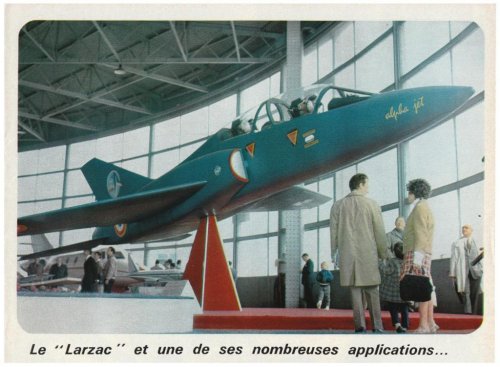Collaboration in a more concrete form (or more accurately, in wood and metal forms) is to be seen in Hall C. where two of the three Franco-German subsonic trainer projects exist in coy juxtaposition as full-scale mock-ups. The first is the E.650 Eurotrainer, proposed jointly by Snias and MBB (Messerschmitt-Bolkow Blohm) with French design leadership. Alongside stands the Alpha Jet, by Dornier and Dassault-Breguet, in which the leader is Germany. The Eurotrainer, in green and brown camouflage, is a low wing design with a high tail, while its counterpart, finished in white, has a shoulder wing and fuselage-mounted tailplane. Both have been designed with private money; government support does not begin until the contractor has been selected.
Both aircraft are twin-engined, and designed to take either the Snecma Larzac of 2,464lb. 10.9kN thrust or the General Electric J85-GE-4 rated at 2,950lb, 13.1kN thrust. The French and German Governments each have a requirement for 200 aircraft, and one of the stipulations in entering the design contest was that a firm in either country would have to team with a partner from the other. Both are designed around a combined trainer/light-strike role (designation TA on the fin of the Alpha Jet denotes training and attack). The winner will replace the venerable Magister in France, but its adoption in Germany will signal the beginning of a new training philosophy for that country. For some years fight crews for the G A F have been trained in America, beginning on Cessna T-37s and graduating to Northrop T-38 Talons. While certainly helping to offset the costs of maintaining American troops in Germany, the forces of nationalism are beginning to press for a "homegrown" product. More to the point, training in clear American skies is hardly a suitable preparation for fighting in proverbially poor European weather.
A model of a similar project, the Type 291 by VFW and Fokker, demonstrates the thoughts of this now-combined Dutch-German firm. This, too. would have twin Larzacs or J85s. but in view of the political constraints mentioned above in connection with the Franco-
German projects, its realisation (at least in response to this competition) appears remote.
































